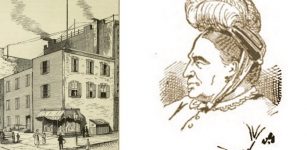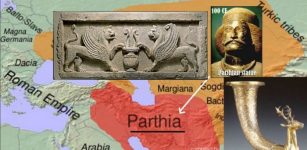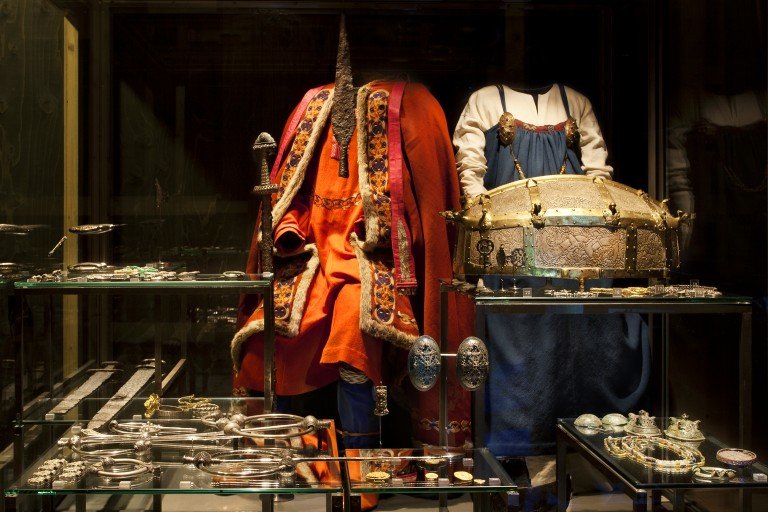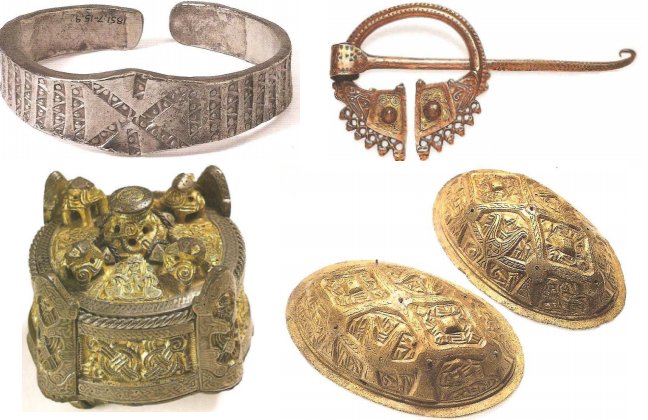Viking Fashion: Men And Women Were Vain And Very Clean During The Viking Age
Ellen Lloyd - AncientPages.com - There are many myths and misconceptions about the Vikings. One is that they were dirty and did not pay attention to their appearance. Few things can be further from the truth. Archaeological discoveries reveal that Vikings were cleaner than most and rather vain.
Credit: IMDb - Fair use
Personal Hygiene Was Very Important To Vikings
Scientists have discovered tweezers, combs, razors, nail cleaners, ear cleaners, and toothpicks inside Viking tombs. These artifacts show that people of the Viking Age took great care in personal grooming.
In his chronicle from 1220, John of Wallingford described the Vikings as well-groomed heartbreakers.
"They had also conquered, or planned to conquer, all the country's best cities and caused many hardships for the country's original citizens, for they were - according to their country's customs - in the habit of combing their hair every day, to bathe every Saturday, to change their clothes frequently and to draw attention to themselves by means of many such frivolous whims.
In this way, they sieged the married women's virtue and persuaded the daughters of even noble men to become their mistresses," Wallingford wrote.
Viking combs. Credit: Mariana Muñoz-Rodriguez
Bone pins, delicately carved from animal bone, were used to fasten clothing or as hair decorations. Vikings paid plenty of attention to their beards and hair. Bones and antlers were carved to create hair combs, which became prized possessions. Hair had to be styled right, and the beard could be short or long, but it was always well-groomed. Archaeologists have confirmed that several Viking combs were produced in Hedeby, a major trading center during the Viking Age.
Viking women, in most cases, had long hair tied into a knot on the back of the head. The knot was often decorated with colorful tape braided into the hair. The women also wore a bonnet or a scarf around their heads.
What Viking outfits looked like remains a mystery because knowledge of Viking fashion is based on fragments of clothes discovered in ancient tombs. Unfortunately, most Viking clothes have rotted away and disappeared when archaeologists excavated their tombs.
It is also important to remember that people living during the Viking Age never spoke of themselves as Vikings. To understand why ancient Scandinavians did not refer to themselves as Vikings, one must remember the meaning of the word Viking. In Old Norse, an old Scandinavian language, the word appears as "vikingr", which designates a person, while "viking" designates a practice. Therefore, it is better to say there are some things we do know about Viking Age fashion.
Our knowledge about Viking fashion is based on artifacts discovered in ancient tombs. National Museum of Denmark
Scientists have successfully produced clothes our ancestors wore by analyzing archaeological finds of textile tools, textiles, skins, and fibers from graves and settlements. For example, Viking Age women usually wore long dresses or skirts that went down to the feet. These dresses were held together with a strap over each shoulder. Men wore the same materials as the women. The inner layer usually consisted of a linen kirtle—a long shirt the men pulled over their heads. On the outside, the typical Viking man wore a wool coat.
Reconstructed woman's and man's costumes from Well-dressed in the Viking Age. Credit: Charlotte Rimstad
Like today's men, Viking men wore trousers. These could be either short or long, and they were usually sewn in the style of pantaloons. These trousers only reached down to the men's knees.
Vikings Loved Colors - Especially Blue And Red
Men usually wore a hat, whereas women could choose between a small hat and a scarf. What has also been discovered is that Vikings loved various colors. The most popular ones were blue and red.
Vikings were also familiar with luxuries such as silk and sewn-on ribbons with silver and golden threads. However, only a few elite members could wear these exclusive fabrics, which were imported worldwide.
Ancient Viking jewelry. Credit: Fitzhugh, William W. - Vikings: The North Atlantic Saga
Astonishing Norse jewelry discovered in hoards and burial sites reveals that Vikings were highly skilled craftsmen. Viking jewelry was beautifully made, and it's still reproduced today.
Vikings certainly paid great attention to beautiful garments and accessories. Based on all these archaeological findings, it's fair to say that Vikings were by no means badly dressed and dirty.
Written by Ellen Lloyd - AncientPages.com
Copyright © AncientPages.com All rights reserved. This material may not be published, broadcast, rewritten or redistributed in whole or part without the express written permission of AncientPages.com
More From Ancient Pages
-
 Has The Body Of Legendary Pirate Black Sam Finally Been Discovered Off The Coast Of Massachusetts?
Archaeology | Feb 17, 2021
Has The Body Of Legendary Pirate Black Sam Finally Been Discovered Off The Coast Of Massachusetts?
Archaeology | Feb 17, 2021 -
 New York’s Queen Of Thieves Fredericka Mandelbaum Opened Marm’s Grand Street School For Criminals
Featured Stories | Jul 24, 2024
New York’s Queen Of Thieves Fredericka Mandelbaum Opened Marm’s Grand Street School For Criminals
Featured Stories | Jul 24, 2024 -
 The Day When The Sun Did Not Come Out – Bizarre Event In 1780, New England
Featured Stories | Apr 18, 2023
The Day When The Sun Did Not Come Out – Bizarre Event In 1780, New England
Featured Stories | Apr 18, 2023 -
 How Many Ice Ages Has The Earth Had, And Could Humans Live Through One?
Featured Stories | Sep 26, 2022
How Many Ice Ages Has The Earth Had, And Could Humans Live Through One?
Featured Stories | Sep 26, 2022 -
 Face Of A Greek Girl That Lived 9,000-Years Ago Reconstructed In Athens
Archaeology | Jan 27, 2018
Face Of A Greek Girl That Lived 9,000-Years Ago Reconstructed In Athens
Archaeology | Jan 27, 2018 -
 Remarkably Well-Preserved 2,500-Year-Old Canoe Discovered In Swiss Lake
Archaeology | Sep 16, 2023
Remarkably Well-Preserved 2,500-Year-Old Canoe Discovered In Swiss Lake
Archaeology | Sep 16, 2023 -
 Your Destiny Is Engraved And Stored – Sacred Ancient Sources Reveal – Part 1
Ancient Mysteries | Jul 10, 2018
Your Destiny Is Engraved And Stored – Sacred Ancient Sources Reveal – Part 1
Ancient Mysteries | Jul 10, 2018 -
 Streets Of Ancient Rome Were Very Dangerous
Ancient History Facts | Feb 29, 2016
Streets Of Ancient Rome Were Very Dangerous
Ancient History Facts | Feb 29, 2016 -
 Ancient People In Peru Had A Unique Response To The Looting And Destruction Of Their Ancestors’ Graves
Archaeology | Feb 3, 2022
Ancient People In Peru Had A Unique Response To The Looting And Destruction Of Their Ancestors’ Graves
Archaeology | Feb 3, 2022 -
 Modern Humans Carrying The Neanderthal Variant Have Less Protection Against Oxidative Stress
Archaeology | Jan 6, 2022
Modern Humans Carrying The Neanderthal Variant Have Less Protection Against Oxidative Stress
Archaeology | Jan 6, 2022 -
 Time Capsule – Best Preserved 3,000-Year-Old Dwelling Ever Found In Britain
Archaeology | Jan 12, 2016
Time Capsule – Best Preserved 3,000-Year-Old Dwelling Ever Found In Britain
Archaeology | Jan 12, 2016 -
 4,000-Year-Old Tomb Of Titi Nab Fu, Pharaoh’s Doctor and ‘Magician’ Unearthed In Saqqara
Archaeology | Jan 8, 2025
4,000-Year-Old Tomb Of Titi Nab Fu, Pharaoh’s Doctor and ‘Magician’ Unearthed In Saqqara
Archaeology | Jan 8, 2025 -
 Amazing ‘Sigiriya’- ‘Lion Rock’ Fortress In Sri Lanka With Frescoes, Mirror Wall And Miniature Gardens
Civilizations | Jan 4, 2019
Amazing ‘Sigiriya’- ‘Lion Rock’ Fortress In Sri Lanka With Frescoes, Mirror Wall And Miniature Gardens
Civilizations | Jan 4, 2019 -
 Virginia’s Mysterious Vault With Remarkable Secret Ancient Documents Still Raises Many Questions
Featured Stories | Oct 17, 2024
Virginia’s Mysterious Vault With Remarkable Secret Ancient Documents Still Raises Many Questions
Featured Stories | Oct 17, 2024 -
 Riddle Of Two Undeciphered Elamite Scripts
Featured Stories | May 19, 2021
Riddle Of Two Undeciphered Elamite Scripts
Featured Stories | May 19, 2021 -
 Next Discovery In Tepe Ashraf, Isfahan – Archaeologists May Have Stumbled Upon Ancient Necropolis
Archaeology | Aug 16, 2020
Next Discovery In Tepe Ashraf, Isfahan – Archaeologists May Have Stumbled Upon Ancient Necropolis
Archaeology | Aug 16, 2020 -
 Likho (Licho): Puzzling And Persistent Demon Of Mischief In Slavic Mythology
Featured Stories | Dec 18, 2016
Likho (Licho): Puzzling And Persistent Demon Of Mischief In Slavic Mythology
Featured Stories | Dec 18, 2016 -
 Albert Pike’s Masonic Prophecy About The Three World Wars
Featured Stories | Jan 15, 2018
Albert Pike’s Masonic Prophecy About The Three World Wars
Featured Stories | Jan 15, 2018 -
 Jambu Tree In Great Cosmogonic Forest Of Sacred Land Of Jambudvipa In Buddhist Mythology
Featured Stories | Nov 2, 2021
Jambu Tree In Great Cosmogonic Forest Of Sacred Land Of Jambudvipa In Buddhist Mythology
Featured Stories | Nov 2, 2021 -
 Denisovan DNA May Explain Why Tibetan Women Thrive In Low Oxygen At High Altitudes For Over 10,000 Years
DNA | Nov 18, 2024
Denisovan DNA May Explain Why Tibetan Women Thrive In Low Oxygen At High Altitudes For Over 10,000 Years
DNA | Nov 18, 2024





